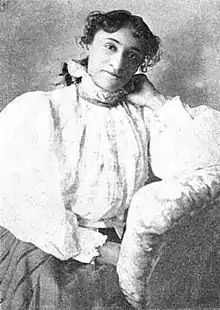Lillian A. Lewis
Lillian A. Lewis (born 1861) was the first African-American woman journalist in Boston.[1] She started her career in the 1880s with the Boston Advocate, a black community newspaper, and in the 1890s began writing for the Boston Herald. To disguise her gender, she used the pen name "Bert Islew".
Lillian A. Lewis | |
|---|---|
 Lillian A. Lewis circa 1897 | |
| Born | 1861 |
| Alma mater | Boston Normal School |
| Occupation | Journalist |
Early life and education
Lillian Alberta Lewis was born in 1861 in Boston. Her childhood home was a stop on the Underground Railroad, and it is thought that one of her parents was an escaped slave. She attended the Bowdoin Grammar School, Girls' High School, and Boston Normal School.[2][3]
Lewis was a gifted student with a literary bent. While still in high school, she took to writing and delivering lectures on subjects such as temperance, usually with a thread of humor running through them. One lecture that was especially popular was "The Mantle of the Church Covereth a Multitude of Humbugs," which poked fun at pious hypocrisy.[4]
Career
Lewis began writing for the Boston Advocate in 1889, using the pen name "Bert Islew" to disguise her gender. ("Islew" is an anagram of "Lewis".) That same year, she made headlines when she was admitted to the New England Woman's Press Association.[5] Sales had been flagging when Lewis joined the Advocate, and her popular society column, They Say, is credited with saving the paper.[4][6] She also contributed to the Richmond Planet and a monthly magazine called Our Women and Children, as well as writing short stories and contributing to various journals.[3] She was one of the few African-American columnists active during the 19th century.[7] Monroe Alpheus Majors wrote of Lewis's work in 1893, "Her pen, as the sword, is ever drawn in defense of her race, and those who have had the honor of crossing weapons with her generally retire from the combat feeling that they have been vigorously fought."[8]
In the 1890s she began working for the Boston Herald as a stenographer and reporter. (A Boston Post announcement in 1892 refers to her as the Herald's "society editress".)[9] She was one of the first African-American women to write for a white-run newspaper.[2] In 1894, Lewis was living on Myrtle Street in Beacon Hill and was considered one of the two "most brilliant and progressive young colored women in Boston." She was a stylish dresser, and moved with ease between Boston's elite South End and West End social sets.[10] She continued writing for the Boston Herald until 1901.[2]
On August 7, 1901 she married Ernest F. Feurtado, a Jamaican.[11] In 1920 she became the first African-American woman clerk in the Collector's Office at Boston City Hall.[12] She retired in 1934.[13]
In 1925 she published a book titled Peter Salem: Colored American Soldier of the American Revolution.[14]
References
- Hayden, Robert C. (1991). African Americans in Boston: More Than 350 Years. Boston Public Library. p. 113. ISBN 0890730830.
- Riley, Sam G. (1995). "Lewis, Lillian Alberta (1861-?)". Biographical Dictionary of American Newspaper Columnists. Greenwood Publishing Group. p. 182. ISBN 9780313291920.
- Willard, Frances Elizabeth; Winslow, Helen Maria; White, Sallie Elizabeth Joy (1897). Occupations for Women. Cooper Union, NY: Success Company. pp. 381–382.
- Penn, I. Garland (1891). "Miss Lillian A. Lewis (Bert Islew)". The Afro-American Press and Its Editors. Springfield, Mass.: Willey & Co. pp. 381–384.
- "Personals". The Pittsburgh Daily Post. November 30, 1889 – via Newspapers.com.
- Scruggs, Lawson Andrew (1893). "Miss Lillian A. Lewis". Women of Distinction: Remarkable in Works and Invincible in Character. L. A. Scruggs. pp. 129–130.
- Sterling, Christopher H. (2009). Encyclopedia of Journalism. SAGE Publications. p. 317. ISBN 9781452261522.
- Majors, Monroe Alpheus (1893). Noted Negro Women: Their Triumphs and Activities. Chicago: Donohue & Henneberry. p. 219.
- "Personal". The Boston Post. September 20, 1892 – via Newspapers.com.
- "Sets in Colored Society". The Boston Globe. July 22, 1894.
- Lord, Myra B. (1932). History of the New England Woman's Press Association, 1885-1931. Newton, Massachusetts: The Graphic Press. p. 145.
- "The Horizon" (PDF). The Crisis. 19 (5): 281. March 1920.
- Boston City Record. 1935.
- Peter Salem: Colored American Soldier of the American Revolution. 1925. OCLC 48461790.